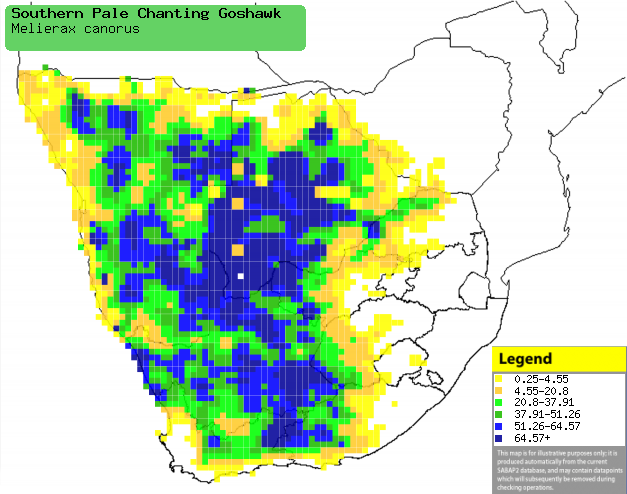|
Melierax canorus (Southern pale
chanting goshawk, Pale chanting goshawk)
Bleeksingvalk [Afrikaans]; Zanghavik [Dutch]; Autour
chanteur [French]; Weißbürzel-singhabicht, Heller grauflügelhabicht
[German]; Açor-cantor-pálido [Portuguese]
Life
> Eukaryotes >
Opisthokonta
> Metazoa (animals) >
Bilateria >
Deuterostomia > Chordata >
Craniata > Vertebrata (vertebrates) > Gnathostomata (jawed
vertebrates) > Teleostomi (teleost fish) > Osteichthyes (bony fish) > Class:
Sarcopterygii (lobe-finned
fish) > Stegocephalia (terrestrial
vertebrates) > Tetrapoda
(four-legged vertebrates) > Reptiliomorpha > Amniota >
Reptilia (reptiles) >
Romeriida > Diapsida > Archosauromorpha > Archosauria >
Dinosauria
(dinosaurs) > Saurischia > Theropoda (bipedal predatory dinosaurs) >
Coelurosauria > Maniraptora > Aves
(birds) > Order: Falconiformes
> Family: Accipitridae
> Genus: Melierax
Distribution and habitat
Near-endemic to southern Africa, occurring from
south-western Angola to Namibia, Botswana, south-western Zimbabwe and the western half of South
Africa. It generally prefers Karoo shrubland, Kalahari woodland, Mopane (Colosphermum mopane)
woodland, Acacia thornveld and riverine woodland in the Namib Desert - any habitat with patches of open ground (exposing prey) and perches
to hunt from.
|
 |
|
Distribution of Southern pale chanting goshawk in southern Africa,
based on statistical smoothing of the records from first SA Bird Atlas
Project (©
Animal Demography unit, University of
Cape Town; smoothing by Birgit Erni and Francesca Little). Colours range
from dark blue (most common) through to yellow (least common).
See here for the latest distribution
from the SABAP2. |
Movements and migrations
It can be both sedentary and nomadic, as
juveniles disperse widely from their parents' territory.
Food
It mainly eats mammals, doing most of its hunting from a
perch, descending to the ground to pursue and strike it's prey. It sometimes
forages in family groups, so that some of the family members can flush prey,
which another family member hunts down. It also follows Black-backed jackals (Canis
mesomelas), Honey badgers (Mellivora capensis), Slender mongooses
(Galerella sanguinea), Rock monitors (Varanus albigularis)
and Cape cobras (Naja
nivea), catching the prey that they disturb. The following food items have been recorded
in its diet:
- Vertebrates
- mammals
- birds
- reptiles
- frogs
- Xenopus laevis (Common platanna)
- carrion
- Invertebrates
Breeding
- Mainly monogamous, but in the Little Karoo it may be cooperatively
polyandrous, as one female can mate with a primary male, while another male
assists them with breeding activities (occasionally mating with the female).
This behaviour only occurs in high-quality territories, which have to be
viciously defended. In fact, males from opposing territories sometimes fight
to the death.
- The nest is built by both sexes (including an additional male if it they
are a trio), consisting of a stick platform with a central cup. This can
be lined with a wide variety of materials, including dung, regurgitated
carnivore pellets, hair, wool, penduline-tit
and prinia nests, Common ostrich
feathers, webs of Social spider (Stegodyphus dumicola), grass,
fabric, paper, string, rope, plastic bags and cabling. When it builds a new
nest each breeding season, it often moves the lining from the old structure to the new
one. The nest can be placed in a variety of sites, especially the
following:
- trees
- Acacia
- A. erioloba (Camel thorn)
- A. luderetzii (Balloon thorn)
- A. hebeclada (Candle-pod thorn)
- A. tortilis (Umbrella thorn)
- A. nigrescens (Knob thorn)
- Colosphermum mopane (Mopane)
- Terminalia prunioides (Purple-pod cluster-leaf)
- Faidherbia albida (Ana-tree)
- Philenoptera violacea (Apple-leaf)
- Gymnosporia senegalensis (Confetti spikethorn)
- Gymnosporia polycantha (Hedge spikethorn)
- Ziziphus mucronata (Buffalo-thorn)
- Tamarix usneoides (Wild tamarisk)
- Boscia (shepherds-tree)
- aliens
- Casuarina equisetifolia (Beefwood)
- Pinus (pines)
- man-made structures
- utility poles
- survey beacons
- steel pylons
- Egg-laying season is from May-December, peaking from July-November.
- It lays 1-2 eggs, which are incubated by both sexes for about 35 days,
both vigorously defending the eggs from intruders.
- At first, the chicks are brooded and fed by the female, with food provided
by the male or males; she later joins them on hunting trips. They leave
the nest at about 44-51 days old, becoming fully independent roughly 30-81
days, after which they remain in their parents' territory for at least one
more year.
Threats
Not threatened.
References
-
Hockey PAR, Dean WRJ and Ryan PG 2005. Roberts
- Birds of southern Africa, VIIth ed. The Trustees of the John Voelcker
Bird Book Fund, Cape Town.
|
